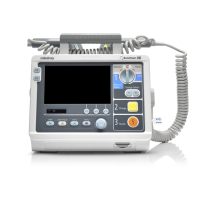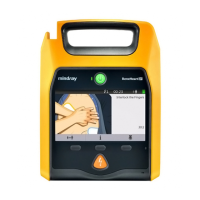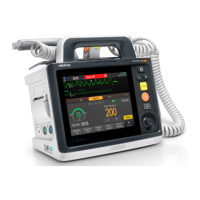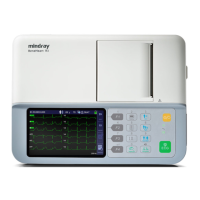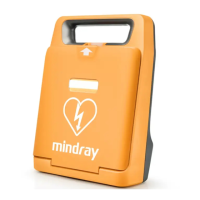
Do you have a question about the Mindray BeneHeart D2 and is the answer not in the manual?
| Brand | Mindray |
|---|---|
| Model | BeneHeart D2 |
| Category | Medical Equipment |
| Language | English |
Provides crucial safety information including dangers, warnings, and cautions.
Provides instructions and warnings for the proper installation of the equipment.
Covers the fundamental steps for operating the equipment, including power and menu navigation.
Classifies alarms into physiological, technical, and prompt messages.
Describes the severity levels of alarms: high, medium, and low.
Details visual and audible indicators used for alarms.
How to navigate and use the alarm setup menu for parameter configuration.
Steps to take and proper actions when an alarm is triggered.
Overview of ECG measurement, its functionality, and intended use.
Critical safety precautions and warnings for ECG monitoring.
Steps for preparing the patient and site for accurate ECG monitoring.
Information about analyzing patient's condition through heart rate and arrhythmia alarms.
Common ECG problems and their corrective actions.
Overview of the AED mode and its process for automated defibrillation.
Critical safety precautions specific to AED operation.
Step-by-step guide for performing defibrillation using the AED mode.
What happens when a shockable rhythm is detected in AED mode.
What happens when a non-shockable rhythm is detected in AED mode.
Overview of manual defibrillation and synchronized cardioversion procedures.
Critical safety precautions for manual defibrillation and cardioversion.
Step-by-step guide for performing manual defibrillation.
How to deliver defibrillator shocks synchronized with the ECG R-wave.
Step-by-step procedure for performing synchronized cardioversion.
Overview of the CPR feedback feature when a CPR sensor is connected.
Overview of the Pacer mode, its functionality, and requirements.
Critical safety precautions and warnings for pacing operations.
Steps to prepare the patient and equipment for pacing.
Critical safety precautions and warnings for respiration monitoring.
Common respiration monitoring issues and their solutions.
Overview of SpO2 monitoring technique and its intended use.
Critical safety precautions and warnings for SpO2 monitoring.
Common SpO2 monitoring issues and their solutions.
Overview of the oscillometric method for non-invasive blood pressure measurement.
Critical safety precautions and warnings for NIBP monitoring.
Steps for performing NIBP measurements, including patient preparation.
Common NIBP issues and their solutions.
Critical safety precautions and warnings for CO2 monitoring.
Common CO2 monitoring issues and their solutions.
Critical safety precautions related to the battery usage and handling.
Explanation of different battery-related alarms and their meanings.
Critical safety precautions related to equipment maintenance and servicing.
Recommended periodic maintenance tests and their frequency.
Performing user-initiated tests for troubleshooting and verification.
Technical specifications related to the defibrillator function.
Technical specifications for the pacing function.
Technical specifications for monitoring functions like ECG, Resp, SpO2.
Technical specifications for respiration monitoring.
Technical specifications for SpO2 monitoring.
Technical specifications for Pulse Rate monitoring.
Technical specifications for NIBP monitoring.
Technical specifications for CO2 monitoring.
Details on alarm levels, categories, and settings.
Describes the methods and criteria used in the rhythm analysis algorithm.
Presents the test results for the algorithm's performance against standards.
Equipment's compliance with electromagnetic compatibility standards.
Performing tests to measure earth leakage current.
Measuring leakage current between applied parts and mains earth.
Testing leakage current from mains to applied parts.
